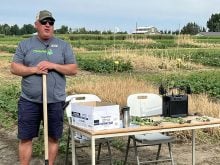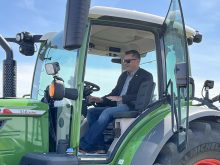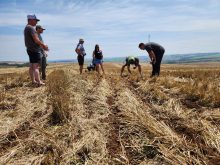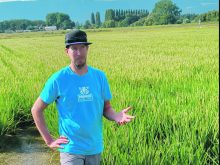Rice needs about 20 inches of water, about the same as irrigated sugar beet and potato crops require in southern Alta.
Scientists are trying to prove that raising rice on the windswept prairies of southern Alberta is not as unlikely as it might first appear.
There is a common misconception that rice can only be grown in flooded fields or paddies in Asia, said Michele Konschuh, an irrigated crop scientist at the University of Lethbridge.
However, certain types of rice could be raised on irrigated but unflooded land in southern Alberta, much like other cereal grains, she said.
“Rice doesn’t actually need to be flooded to grow… we just need to keep them moist.”
Paddies are used to allow farmers to tackle pest and weed problems without using chemicals such as herbicides, said Konschuh.
“Rice just doesn’t like to dry out and in many parts of the world, they have a lot of water, and they can reduce weed pressure by flooding.”
It is vital to explore raising different and unfamiliar crops on the Canadian Prairies, she said.
“One of the things we keep hearing about in the news all the time is climate change, and that the world’s warming up and things will get hotter.”
The prospect of the Prairies also getting drier doesn’t sound good for rice, said Konschuh. However, a hotter climate might force a shift from crops that prefer a cooler climate to plants that can handle more heat, she said.
“I wouldn’t say it’s vital at this point that it’s rice in particular, but I think that it’s always important to be looking at other crops that could potentially adapt to being grown here, or that we could learn to grow if we needed to.”
Besides the University of Lethbridge, the rice project involves Farming Smarter at its fields east of the city. The initiative was sparked last year by Calgary-based Galaxy Ag Ventures, which is a company that focuses on investments in agriculture.
Any rice grown in southern Alberta likely won’t compete in grocery stores against imported rice, but will instead be fractionated into value-added food products, said Konschuh.
“Rice is naturally gluten free and it would be for rice flour, rice oils, rice protein — all of those become ingredients in gluten-free products people use.”
Southern Alberta rice producers will enjoy the advantages of being part of the Canadian food production system, which is internationally trusted because of policies such as the use of registered chemicals and how workers are treated, she said.
Canada also rarely has soils that have been contaminated with heavy metals compared to rival countries, “so there are some attributes that maybe are important when you’re sourcing your material,” said Konschuh.
Scientists in southern Alberta are examining the feasibility of growing a type of rice called upland rice. The crop is commercially grown in North America in parts of the United States ranging from Arkansas and California to Missouri, Texas and Louisiana, said research co-ordinator Michael Gretzinger of Farming Smarter.
Cultivation has also been explored in British Columbia and southern Ontario, he said.
“There’s maybe parts of the U.S. and parts of Canada that get enough rainfall, but I think it needs close to about 20 inches, so about the same irrigation that you would use for a sugar beet or potato crop in southern Alberta is about what we’re (expecting) for the rice.”
Although upland rice is also known as dryland rice, such requirements mean the crop isn’t suitable for dryland farming on the Canadian Prairies, he said.
“There’s just no way you could grow it in parts of central Alberta, Saskatchewan or whatever, if you only get five or six inches fall a year, or even 10 or 12 isn’t probably enough.”
Another hurdle involves the photoperiod or amount of daylight required by upland rice, said Konschuh, who is also an associate professor of biological sciences.
“It helps the plant tell where it is in the growing season so that it knows when to start producing seed and propagating for the following year.”
The upland rice tested by Farming Smarter, which was sourced from areas within countries such as Korea and the U.S. that are at a lower latitude, has a strong requirement for about 11 hours of daylight or less, she said.
However, the photoperiod can be as high as 16 hours in southern Alberta and remains at 12 hours even in late September, said Konschuh. If rice does not get the signal to flower until after that time, there typically isn’t enough of the season left for the plants to finish, she said.
The growing season might sometimes be prolonged by a mild fall, but nighttime temperatures usually become steadily colder, which means frost often comes early to southern Alberta, she said. Researchers at Farming Smarter grew some panicles and seeds last year, but few plants were able to reach maturity, she added.
“We either need to have rice that’s not photoperiod sensitive, or rice that’s been selected in a climate similar to ours, and an elevation and things like that, so that we have that day length component addressed.”
Upland rice is grown in areas of the world ranging from parts of China and northern Japan to Europe, she said.
“They obviously have overcome that problem and use varieties suitable for their area, and we would still need to bring those here to be able to look at that.”
Three different planting methods were tried during the first year of the project, including transplanting and direct seeding using a seed drill, said Konschuh. Researchers also tried seed film cultivation, which involves attaching seed to a biodegradable plastic film to reduce weeds.
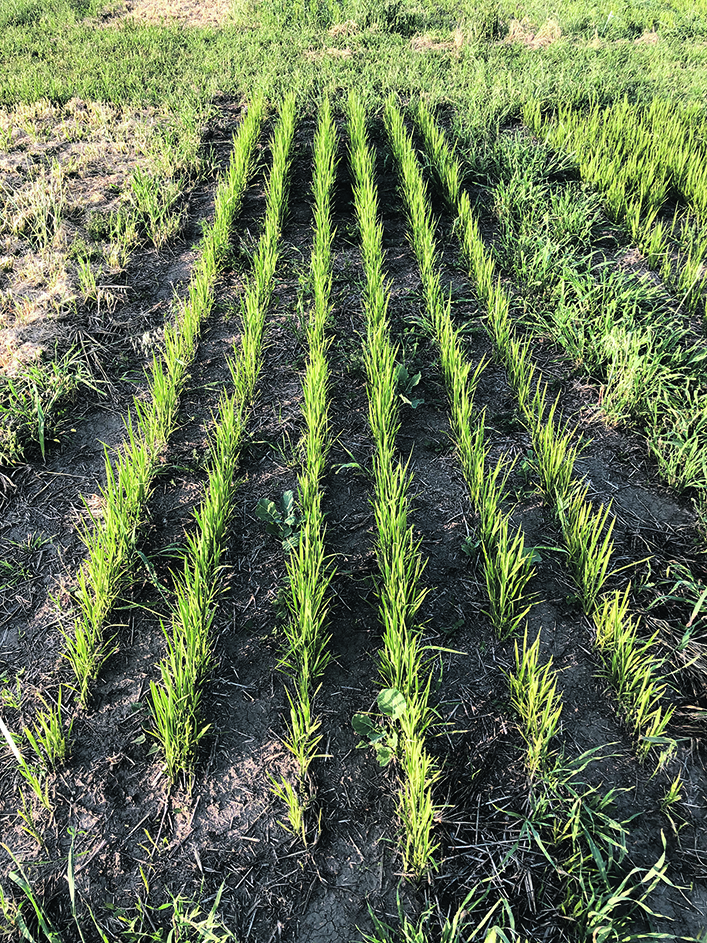
“The transplanted probably did the best, but it’s very labour intensive and requires starting with plants in a greenhouse. And direct seeding actually worked reasonably well last year, but the seed came to us quite late.”
Gretzinger said the biggest challenge is ensuring the upper part of the soil is kept a bit wetter.
“I think the rice doesn’t like to dry out and get wet and dry out as much as some other grasses may tolerate and like.”
Two types of irrigation were tested, said Konschuh, “and we found that overhead irrigation could certainly work with rice. Subsurface drip, we didn’t have great luck with, but it was also not being irrigated for the rice. It was just in a field with other subsurface drip crops and we had to take what we could get, so I think there’s still more that can be explored in that vein.”
The fertility program for upland rice is also heavier in terms of nitrogen, said Gretzinger.
“We’ve got to do a couple of in-crop broadcasts, or triple banding or something where we put some nitrogen on because we find that the crop just tends to stay yellow and stunted unless we put quite a bit of nitrogen on.”
If upland rice proves suitable for southern Alberta, it will likely be part of crop rotations in much the same way as wheat or barley are grown to provide a break from some of the higher-value crops, said Konschuh. However, farmers will need to be convinced upland rice will make business sense for their operations, she said.
“I think we’re still probably 10 years away from having any level of commercial production here, and perhaps more. If we were doing breeding from scratch, it could take even longer, but I think what we’d like to do is work with breeders and people who grow crops in other parts of the world more similar to here, and then we can get there a bit faster.”




